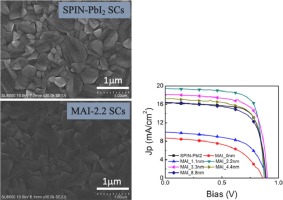Organic Electronics ( IF 3.2 ) Pub Date : 2020-03-17 , DOI: 10.1016/j.orgel.2020.105713 Wei-Chih Lai , Wen-Ming Hsieh , Huai-Cheng Yu , Siou-Huei Yang , Tzung-Fang Guo , Peter Chen

|
The thermally deposited thin methylammonium iodide (MAI) interlayer worked as protection layer of poly (3, 4-ethylenedioxythiophene) poly (styrene sulfonate) (PEDOT:PSS) in the thermal deposition of lead iodide (PbI2). And the thin MAI interlayer could be the MAI supplemental layer during converting the thermally deposited PbI2 into perovskite. The performances of perovskite solar cells (SCs) converted from thermally deposited PbI2 were remarkably enhanced by using the thin MAI interlayer on PEDOT:PSS. The short-circuit current density (JSC), fill factor (FF%), and conversion efficiency (η%) of perovskite SCs converted from thermally deposited PbI2 increased with the initial increase in thickness of the thin MAI interlayer and then reduced when the thickness of thin MAI interlayer exceeded 2.2 nm. Perovskite SCs converted from thermally deposited PbI2 with a 2.2 nm-thick thin MAI interlayer obtained the largest JSC, FF%, and η% at 19.44 mA/cm2, 74% and 12.75%, respectively, in our study. And the largest JSC was more than twice larger than that of perovskite SCs converted from thermally deposited PbI2 without thin MAI interlayer. Although the perovskite SCs converted from thermally deposited PbI2 without thin MAI interlayer has η% much less than that of perovskite SCs converted from spin-coated PbI2. The perovskite SCs converted from thermally deposited PbI2 with 2.2 nm-thick thin MAI interlayer had an η% of 12.75%, which was larger than that of perovskite SCs converted from spin-coated PbI2 at 10.57%.
中文翻译:

从热沉积的碘化铅通过薄的碘化甲基铵中间层转换而来的甲基碘化三碘化铅钙钛矿型太阳能电池的转换效率提高
热沉积的薄甲基碘化碘(MAI)中间层在碘化铅(PbI 2)的热沉积中用作聚(3,4-乙二氧基噻吩)聚苯乙烯磺酸盐(PEDOT:PSS)的保护层。而且,在将热沉积的PbI 2转化为钙钛矿期间,薄的MAI中间层可能是MAI的补充层。通过在PEDOT:PSS上使用薄的MAI中间层,可以显着提高从热沉积的PbI 2转换而来的钙钛矿太阳能电池(SCs)的性能。由热沉积的PbI 2转换得到的钙钛矿SC的短路电流密度(J SC),填充系数(FF%)和转换效率(η%)随着薄MAI中间层厚度的初始增加,其增加,然后当薄MAI中间层的厚度超过2.2 nm时减小。钙钛矿的SC从热沉积碘化铅转化2具有2.2 nm厚的薄夹层MAI获得的最大Ĵ SC,FF%,和η%在19.44毫安/厘米2分别为74%和12.75%,在我们的研究。并且最大的J SC大于钙钛矿SC的两倍以上,后者是由没有薄MAI中间层的热沉积PbI 2转化而来的。尽管从没有薄MAI中间层的热沉积PbI 2转化得到的钙钛矿SC的η%要比从旋涂PbI 2转化得到的钙钛矿SC的η%小得多。。由具有2.2nm厚度的薄MAI中间层的热沉积PbI 2转化得到的钙钛矿SC的η%为12.75%,大于从旋涂PbI 2转化得到的钙钛矿SC的10.57%。



























 京公网安备 11010802027423号
京公网安备 11010802027423号